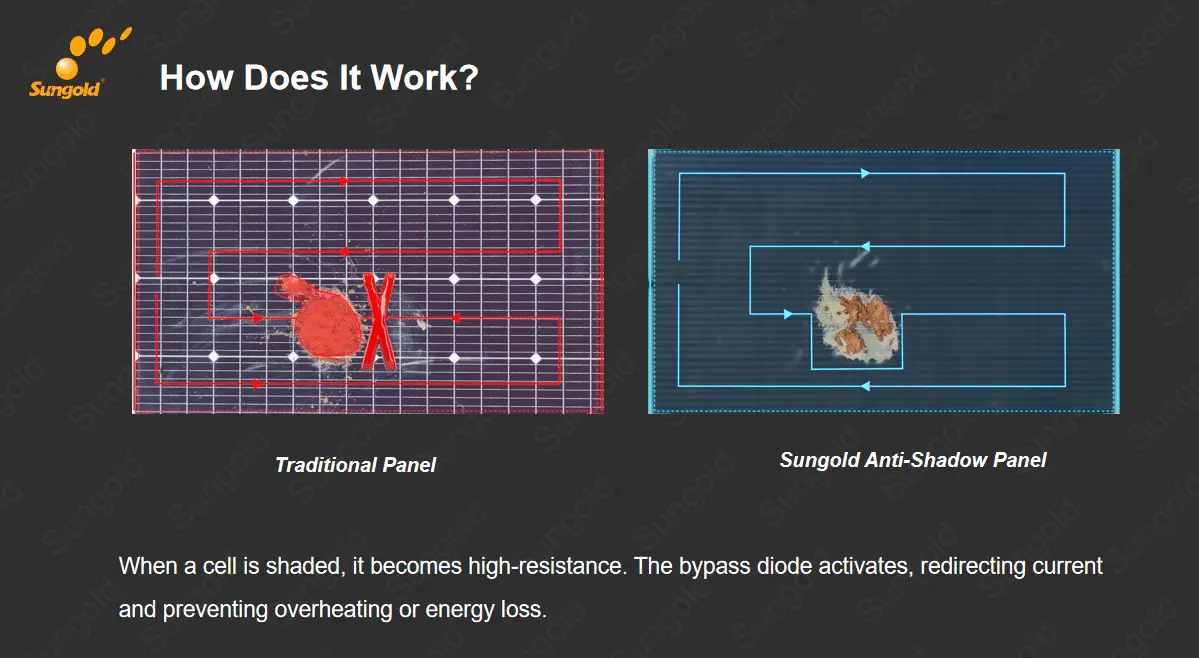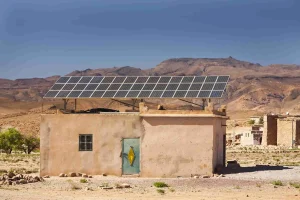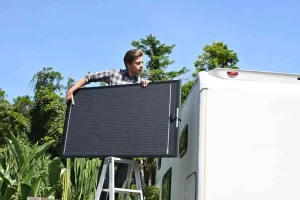Anti-shading solar panels are designed to maintain power output even when partially blocked by shadows. They use solar bypass diodes to reroute current around shaded cells, minimizing heat buildup (hot spots) and power loss. Ideal for rooftops, RVs, balconies, or tree-lined areas, they outperform traditional solar panels in variable light conditions.
Why Do Shaded Solar Panels Lose Power?
When even one solar cell is shaded—by a leaf, tree, bird droppings, or a nearby structure—the entire module’s output can drop sharply. This is because most solar panels connect cells in series, meaning:
Current flows through each cell in a chain.
If one cell’s current drops, the entire string’s current drops.
Unshaded cells continue to generate current, which is dissipated as heat in the shaded cell, creating a hot spot.
In short: A small shadow can ruin a large panel’s output.

What Is the Hot Spot Effect in Solar Panels?
The hot spot effect happens when shaded cells begin to overheat due to reverse voltage.
How it happens:
A shaded cell stops producing energy.
It becomes a resistive load (like a heater).
As current from other cells flows through it, it overheats.
🔥 Consequences of hot spots:
Reduced panel efficiency
Degraded encapsulation (EVA yellowing)
Risk of cell cracking or fire in extreme cases
Shaded environments = high risk of permanent damage.

How Do Bypass Diodes Prevent Power Loss?
Bypass diodes are the key to building anti-shade solar panels. These electronic components are installed across groups of cells inside a panel.
What they do:
When cells are fully illuminated: diodes are inactive.
When some cells are shaded: diodes activate, allowing current to bypass the shaded cells.
This prevents overheating and allows the rest of the module to keep working.
Think of it as an alternate route for the electricity to flow around a blocked area.
solar bypass diodes partial vs full shading
Partial shading is more technically challenging than full shading because diode activation thresholds must be low and precise. Otherwise, even small shadows can lead to hot spots and energy loss. Full shading, while more disruptive, is more predictable and easier to manage.
With Sungold’s Technology, featuring cell-level diode control, the system responds faster and protects smaller zones, offering true anti-shade solar panel performance—ideal for rooftops, RVs, marine, and urban solar use cases.
| Aspect | Partial Shading | Full Shading | Bypass Diode Control Impact |
|---|---|---|---|
| Shading Scope | Only some cells or part of a cell group are shaded | Entire string (e.g., 18–24 cells) or full panel is shaded | Partial shading requires more precise and sensitive diode control to avoid delayed response and hot spots |
| Current Behavior | String current drops to the level of the weakest (shaded) cell | String current drops to near zero | Once activated, bypass diodes reroute current around affected zone, preserving output of the rest of the system |
| Power Loss | Moderate to severe, depending on diode trigger sensitivity | Severe, as entire string/module may shut down | Good diode zoning minimizes loss area and keeps unaffected sections working |
| Hot Spot Risk | High, especially if diode doesn’t activate quickly | Low, since current is bypassed completely | Requires quick diode response in partial shading; Sungold’s 863 design reduces thermal stress |
| Bypass Diode Activation | May or may not activate depending on partial shading threshold | Almost always activated | Fine-grained design like Sungold’s 863 enables faster activation in small shaded areas |
| Impact on Other Modules | If not bypassed, the entire module or string is affected by one shaded cell | Other modules/strings can keep operating | Localized bypass prevents one issue from affecting entire array |
| Optimization Strategy | Increase number of bypass zones, reduce number of cells per diode | Use traditional diodes + MPPT tracking | Cell-level shadow management (e.g., Sungold 863) is key to high-efficiency in shaded environments |
What’s Cell-level shadow management technology?
Sungold embeds bypass components inside the module to reroute current around shaded cells, reducing hotspot risk and improving overall power output.
Want to see how it works? Try our interactive shading simulation tool to explore real-time performance under different shading conditions.
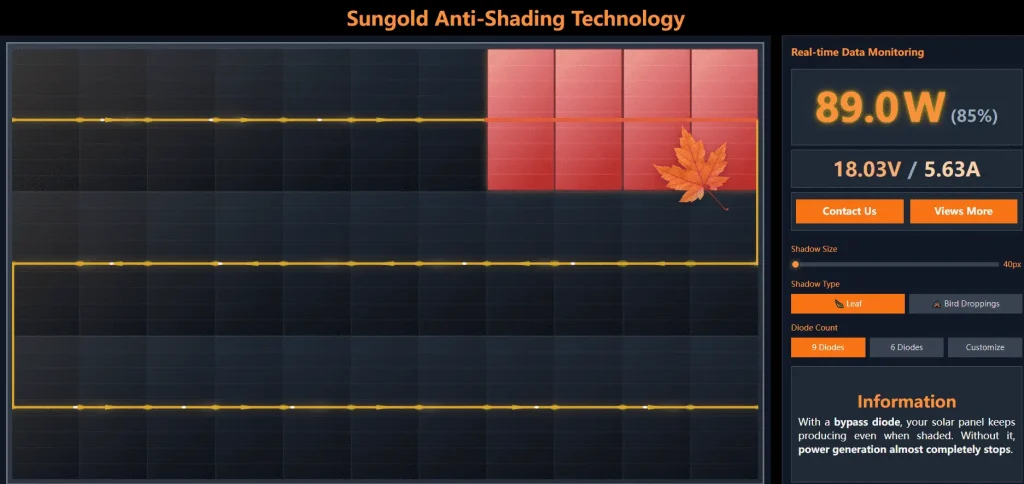
Why Choose Sungold Anti-Shading Solar Panels?
Sungold Solar’s anti-shading technology solves the industry pain point of shading-induced hot spots through:
✅ Multiple bypass zones – minimize affected area
✅ Smaller diode-controlled groups – more precise protection
✅ Enhanced safety – reduced overheating risks
✅ Higher long-term efficiency in real-world use
✅ Certified by TÜV, CE, FCC, RoHS, and more
Performance Comparison
| Condition | Traditional Panel | Sungold Anti-Shade Panel |
|---|---|---|
| Partially Shaded | Output drops >50% | Output drop ≤15% |
| Fully Shaded Cell | Risk of hot spot | Safe rerouting of current |
| Bypass Activation | Delayed or absent | Instant diode response |
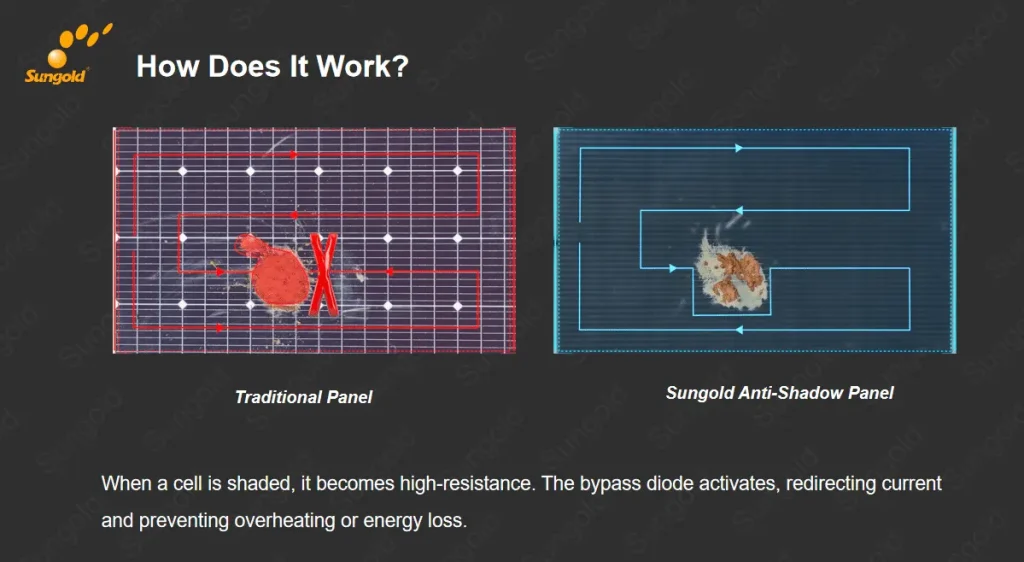
Best Use Cases for Shade-Tolerant Solar Panels
B2B clients who benefit most from shade-tolerant solar panels include:
Residential solar installers (with tree or roof shading)
RV and marine solar providers
Solar panel distributors in urban areas
OEMs and e-commerce companies selling portable kits
Off-grid solar kit builders in forested or uneven terrain
If your system faces non-uniform sunlight, you need anti-shade solar panels.
Is It Worth Upgrading to Anti-Shading Panels?
Absolutely. If any part of your solar installation experiences variable lighting conditions, investing in Sungold anti-shade solar panels means:
Fewer maintenance issues
Longer component lifespan
Higher energy yield
Lower risk of hot spot failures
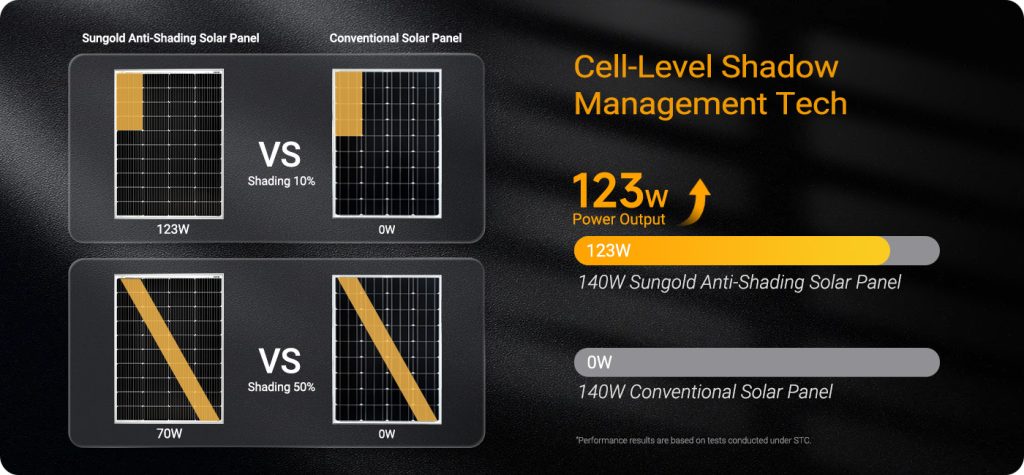
Final Thoughts
Shading is an unavoidable reality in most real-world solar installations—whether on rooftops, RVs, marine vessels, or off-grid systems. But it doesn’t have to compromise your system’s performance or safety.
With Sungold’s anti-shading-solar-panels, powered by proprietary Cell-level shadow management technology and intelligent bypass diode architecture, you gain:
✔️ Higher energy yield in partial or full shading
✔️ Protection against hot spots and thermal damage
✔️ Greater long-term reliability and system ROI
For solar professionals and procurement managers, investing in shade-tolerant solar panels is no longer a luxury—it’s a necessity for optimal system design.

